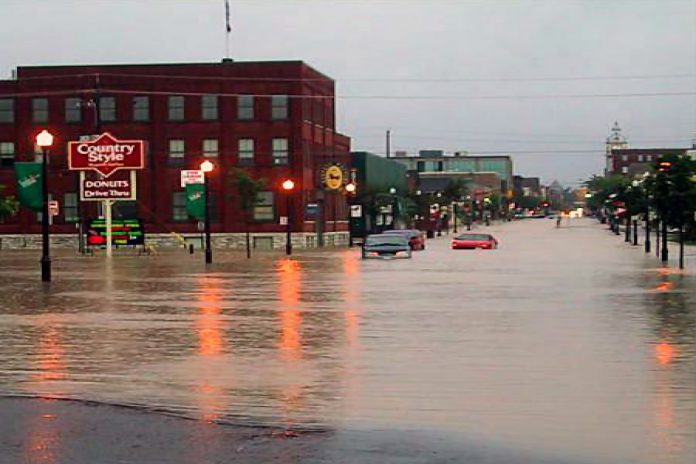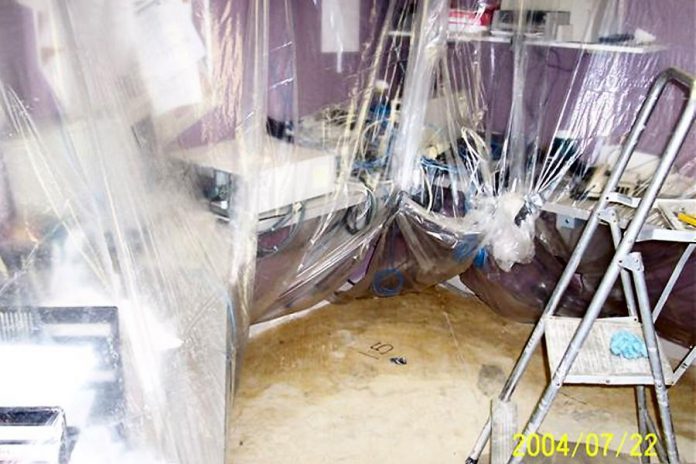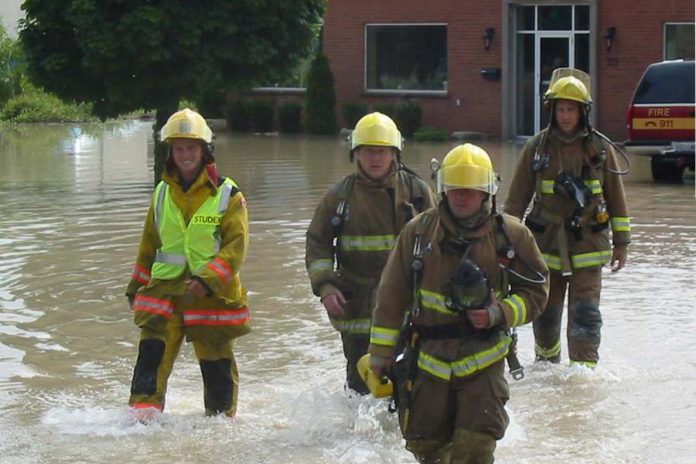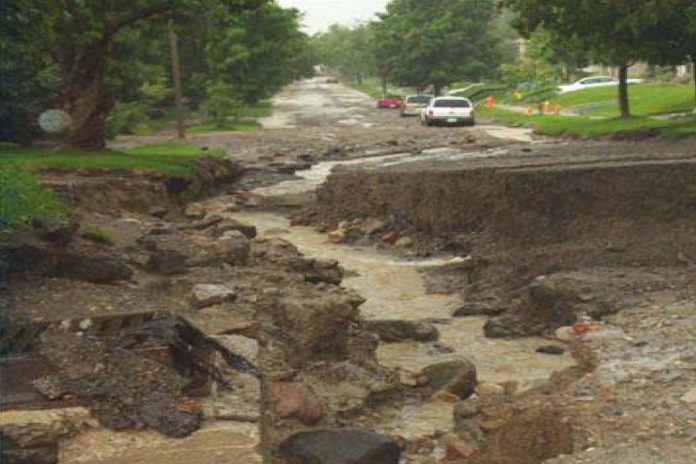
It was 15 years ago today (July 15, 2019) that Peterborough experienced what has become known as the Great Peterborough Flood.
From the evening of Wednesday, July 14, 2004 to the morning of Thursday, July 15, 2004, as many as 240 millimetres (9.5 inches) of rain fell in Peterborough, with much of it falling within a five-hour period on the morning of July 15th.
In all, 14 billion litres of rain fell on Peterborough in a single day — the same amount of water that flows over Niagara Falls in about 40 minutes.

The origins of the 2004 Peterborough flood came from a weather system in Alberta three days before. On Sunday, July 11, 2004, the City of Edmonton experienced a small but spectacular storm that dumped more than 150 mm of rain in parts of the city in less than an hour.
Mud and water poured down streets and through windows. A record flash flood washed out roads, filled underpasses, flooded basements, turned streets into rivers and intersections into lakes. Enormous water pressure in the sewer system blew hundreds of manhole covers into the sky.
That same storm system slowly worked its way east across Canada, travelling 2,700 kilometres until it reached Peterborough on Wednesday, July 14th. There, fed by cool air from the north and moist air from the south, the system produced intense rainstorms that began on Wednesday evening and continued for five hours during the early morning hours of Thursday, July 15th.

The amount of rain that fell on Peterborough during the storm varies, from 100 mm (4 inches) recorded at the Peterborough Airport to 240 mm (9.5 inches) recorded at Trent University. Much of the rain fell in less than five hours early Thursday morning, with 78.8 mm (3 inches) falling between 3:30 a.m. and 4:30 a.m. alone.
Peterborough’s drain and sewer system was unable to cope with that much storm water. Normally, the city’s sewage system deals with about 1.3 million gallons per day; during the storm, the sewage treatment plant measured a peak flow of 7 million gallons of waste water.
At the time of the storm, over 80 per cent of the pipes in the city’s storm water system were undersized and didn’t meet modern standards (some had been built in the prior century), creating bottlenecks in moving the flood water.
Downtown Peterborough, where the rainfall was concentrated, consists of largely impervious paved surfaces, including streets that are not well designed to convey flood water over land. In addition, groundwater that seeped into cracked or misaligned sewer pipes created excess water in the system, leading to back-ups and basement flooding.
It was the perfect storm for a perfect storm. The city’s sewer system couldn’t deal with the volume of water, resulting in sudden and severe flooding.
“As I neared downtown — one of the low-lying areas of a city built around seven hills — it became apparent all was not well,” recalled Peterborough broadcaster and author Gordon Gibb in a story he wrote for the Toronto Star, as he travelled to the former Kruz FM’s newsroom in downtown Peterborough on the morning of the flood. “There were small lakes where the pavement was supposed to be, confusing traffic and causing a few people to abandon their cars.”

“My own destination turned out to be one of the worst-hit areas. King Street crosses over Jackson Creek, which had swelled into the thoroughfare, adding to the chaos. My four-wheel-drive Jeep, in spite of a healthy ground clearance, proved no match for the water, leaving me to wade against a raging river that, until an hour before, had been a city street.”
“Grabbing light standards along the sidewalk for support, I made my way to the entrance of our ground-floor offices, and began to digest the seriousness of the situation. I have seen floods before, the result of a sudden and dramatic rainfall. But this was something else again. This was a disaster movie, unfolding before my very eyes.”
Peterborough’s Fire Department was inundated with calls from across the entire city, ranging from flooded basements to fire alarms. City utility and social services were overburdened with responding to the consequences of the flooding.

The City of Peterborough declared a state of emergency after the storm, which stayed in effect for two weeks. Many city staff worked 18- to 20-hour days until the state of emergency was lifted on July 29th.
Here are some interesting facts about the impact of the flood:
- 171 long-term care residents were evacuated from Extendicare Nursing Home to the Evinrude Centre
- 500 homes and businesses had hydro meters pulled from flooded basements
- Hundreds of flood-damaged water heaters required replacement
- 1,000 homes had gas lines disconnected
- 498 electrical systems were disconnected
- There were 28 motor vehicle accidents
- The city issued emergency clothing to more than 1,300 people and emergency food to more than 1,000 households
- The Salvation Army served over 10,000 meals
- Firefighters pumped out over 1,868 basements, garages, and backyards
- 25 people who were trapped in or on cars needed to be rescued
- Cleaning up flood-related garbage and debris was a major undertaking. Around 12,500 tons of materials were placed in the landfill in the two weeks following the flood (four times the normal amount)
- Both the Peterborough Public Library and the adjoining Peterborough Museum and Archives were flooded, with 10 per cent of documents, photographs, and negatives in the conservation area and storage vault under water for 24 hours.
In the end, the flood resulted in $95 million in insured losses in Peterborough, according to the Insurance Bureau of Canada. Overtime and expenses for city staff responding to the flood amounted to $1.4 million.
Costs of repairs and restoration (including roads, bridges, culverts, buildings, and the Museum photo archives) equalled $21 million. In addition, the Province of Ontario provided $25 million for emergency repair and restoration costs for city infrastructure. The amount of revenue and productivity that businesses and residents lost because of the flood can only be estimated.

Making matters worse, the 2004 flood came only 25 months after another major flood in June 2002, when Peterborough suffered through a severe summer storm that generated more than 70 mm (3 inches) of rain in a 24-hour period. Many Peterborough residents and business owners had just recovered from damages caused by the 2002 flood when they were hit again by the 2004 flood.
Shortly after the 2004 flood, the City of Peterborough hired UMA Engineering Ltd. (now known as AECOM Ltd.) to prepare a Flood Reduction Master Plan (FRMP). Since the completion of the plan in 2005, the city has undertaken a series of studies to assess vulnerability and has begun to take action, updating stormwater management designs and infrastructure to protect the city from future flooding damage.
Following the flood, the city completed numerous projects, including studies recommended by the FRMP, diversion projects, storm sewer retrofits, and culvert replacements.

In addition to upgrading infrastructure, the city offered financial incentives to encourage the disconnection of foundation drains from the sanitary sewer system, use of rain barrels, and the installation of backwater valves in previously affected areas.
For more information on how the City of Peterborough now prepares for flooding, and mitigates the potential for flooding, visit the Emergency Services – Flooding and Water and Sewers – Flood Reduction pages on the city’s website, with the latter including information about the city’s Flood Reduction Subsidy Program and Flood Reduction Master Plan.
All photos courtesy of City of Peterborough Emergency & Risk Management Division except where noted.


























